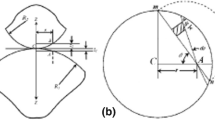Abstract
Accurate modeling of fluid flow through sedimentary units is of great importance in assessing the performance of both hydrocarbon reservoirs and aquifers. Most sedimentary rocks display structure from the mm or cm scale upwards. Flow simulation should therefore begin with grid blocks of this size in order to calculate effective permeabilities for larger structures. In this paper, we investigate several flow models for sandstones, and examine their impact on the calculation of effective permeability for single phase flow. Crossflow arises in some structures, in which case it may be necessary to use a tensor representation of the effective permeability. We establish conditions under which tensors are required, e.g., in crossbedded structures with a high bedding angle, high permeability contrast, and laminae of comparable thickness. Cases where the off-diagonal terms can be neglected, such as in symmetrical systems, are also illustrated. We indicate how the method of calculating tensor permeabilities may be extended to model multiphase flow in sedimentary structures.
Similar content being viewed by others
References
Aasum, Y., Kelkar, M. G., and Gupta, S. P., 1991, Effect of scaling parameters on miscible displacement: Multiphase transport in porous media: ASME, p. 93–102.
Alabert, F. G., and Corre, B., 1991, Heterogeneity in a Complex Trubiditic Reservoir: Impact on Field Development: SPE 22902, Presented at the 66th Annual Technical Conference of the SPE, Dallas, Texas.
Allen, J. R. L., 1984.Developments in Sedimentology, 30, Sedimentary Structures, Their Character and Physical Basis: Elsevier, Amsterdam.
Arfken, G., 1985,Mathematical Methods for Physicists: Academic Press, San Diego, CA.
Bourgeat, A., 1984, Homogenized behaviour of two-phase flows in naturally fractured reservoirs with uniform fractures distribution: Comp. Meth. App. Mech. Eng., v. 47. p. 205–216.
Corbett, P. W. M., and Jensen, J. L., 1993, An application of probe permeametry to prediction of two-phase flow performance (Lower Brent Group, North Sea): Marine Petroleum Geo., v. 10, n. 4, p. 335–346.
Corbett, P. W. M, Ringrose, P. S., Jensen, J. L., and Sorbie, K. S., 1992, Laminated Clastic Reservoirs—The Interplay of Capillary Pressure and Sedimentary Architecture: SPE 24699, Ann. Tech. Conf. Washington, October, 4–7.
Durlofsky, L. J., 1991, Numerical calculation of equivalent grid block permeability tensors for heterogeneous porous media: Water Res. Res., v. 27, p. 699–708.
Durlofsky, L. J., 1992, Modeling fluid flow through complex reservoir beds: SPE Formation Evaluation, v. 7, n. 4, p. 315–322.
Durlofsky, L. J., and Chung, E. Y., 1990, Effective Permeability of Heterogeneous Reservoir Regions: Proc. 2nd European Conference on the Mathematics of Oil Recovery, D. Guerillot and O. Guillon, (Eds.), Edition Technips, Paris, p. 57–64.
Goggin, D. J., Chandler, M. A., Kocurek, G., and Lake, L. W., 1988, Patterns of permeability in eolian deposits: Page sandstone (Jurassic), NE Arizona: SPE Formation Evaluation, v. 3, n. 2, p. 297–306.
Gomez-Hernandez, J. J., and Journel, A. G., 1990, Stochastic Characterization of Grid-Block Permeabilities: From Point Values to Block Tensors: Proc. 2nd European Conference on the Mathematics of Oil Recovery, D. Guerillot and O. Guillon, (Eds), Editions Technips, Paris, p. 57–64.
Hsu, K. J., 1989,Physical Principles of Sedimentology: Springer-Verlag, New York.
Hurst, A., and Rosvoll, K. J.. 1991, Permeability variations in sandstones and their relationships to sedimentary structures: in L. W. Lake, H. B. Carroll, Jr., and T. C. Wesson (Eds.),Reservoir Characterization II: Academic Press, San Diego, CA, p. 166–196.
Kasap, E., and Lake, L. W., 1990, Calculating the effective permeability tensor of a grid block: SPE Formation Evaluation, v. 5, n. 2, p. 192–200.
Marsily, G., de. 1986,Quantitative Hydrogeology, Academic Press, San Diego.
Matheron, G., 1967, Elements pour une théorie des milieux poreux, Maison et Cie, Paris.
Mei, C. C., and Auriault, J.-L., 1989, Mechanics of heterogeneous porous media with several spatial scales: Proc. R. Soc. Lond. A, v. 426, p. 391–423.
Pettijohn, F. J., Potter, P. E., and Siever, R., 1987,Sand and Sandstones (2nd ed.): Springer-Verlag, New York, p. 100.
Pickup. G. E., Jensen, J. L., Ringrose, P. S., and Sorbie, K. S., 1992, A Method for Calculating Permeability Tensors using Perturbed Boundary Conditions: Proc 3rd European Conference on the Mathematics of Oil Recovery, Delft University Press, p. 225–237.
Ringrose, P. S., Pickup, G. E., and Corbett, P. W. M., 1993a. The Effects of Small-Scale Reservoir Architecture on Hydrocarbon Flow Illustrated Using an Outcrop in Fife, Scotland: 1993 AAPG International Conference, The Hague, October 17–20.
Ringrose, P. S., Sorbie, K. S., Corbett, P. W. M., and Jensen, J. L., 1993b, Immiscible flow behaviour in laminated and crossbedded sandstones: J. Petroleum Sci. Engineer., v. 9. p. 103–124.
Smith, L., and Freeze, R. A., 1979, Stochastic analysis of steady state groundwater flow in a bounded domain. 2. Two-dimensional simulations: Water Res. Res., v. 15, n. 6., p. 1543–1559.
Sorbie, K. S., Feghi, F., Pickup, G. E., Ringrose, P. S., and Jensen, J. L., 1994, Flow Regimes in Miscible Displacements in Heterogeneous Correlated Random Fields: SPE Advanced Technology Series, v. 2. no. 1, In press.
Stam, J. M. T., and Zijl, W., 1992, Modeling permeability in imperfectly layered porous media. II. A two-dimensional application of block-scale permeability: Math. Geol., v. 24, n. 8, p. 885–904.
Waggoner, J. R., Castillo, J. L., and Lake., L. W., 1991, Simulation of EOR processes in stochastically generated permeability media: SPE Formation Eval., v. 7, n. 2, p. 173–180.
White, C. D., and Horne, R. N., 1987, Computing Absolute Transmissibility in the Presence of Fine-Scale Heterogeneity: SPE 16011.
Zapata, V. J., and Lake, L. W., 1981, A Theoretical Analysis of Viscous Crossflow: SPE 10111, presented at the 56th Annual Fall Technical Conference and Exhibition of the Society of Petroleum Engineers, San Antonio, Texas.
Zijl, W., and Stam, J. M. T., 1992, Modeling permeability in imperfectly layered porous media. I: Derivation of block-scale permeability tensor for tine grid blocks: Math. Geol., v. 24, n. 8, p. 865–883.
Author information
Authors and Affiliations
Rights and permissions
About this article
Cite this article
Pickup, G.E., Ringrose, P.S., Jensen, J.L. et al. Permeability tensors for sedimentary structures. Math Geol 26, 227–250 (1994). https://doi.org/10.1007/BF02082765
Received:
Accepted:
Issue Date:
DOI: https://doi.org/10.1007/BF02082765




